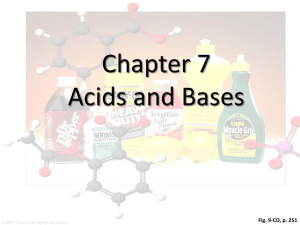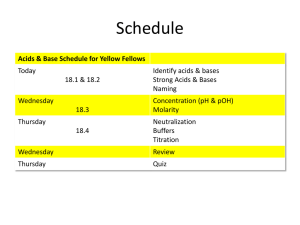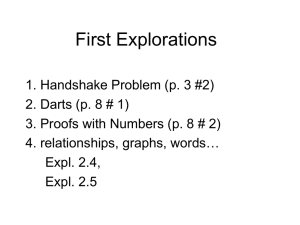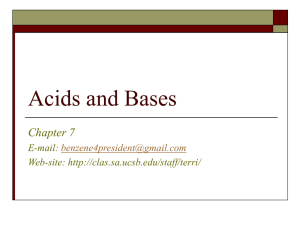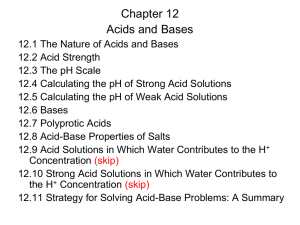Bronsted-Lowry Acid-Base Model
advertisement
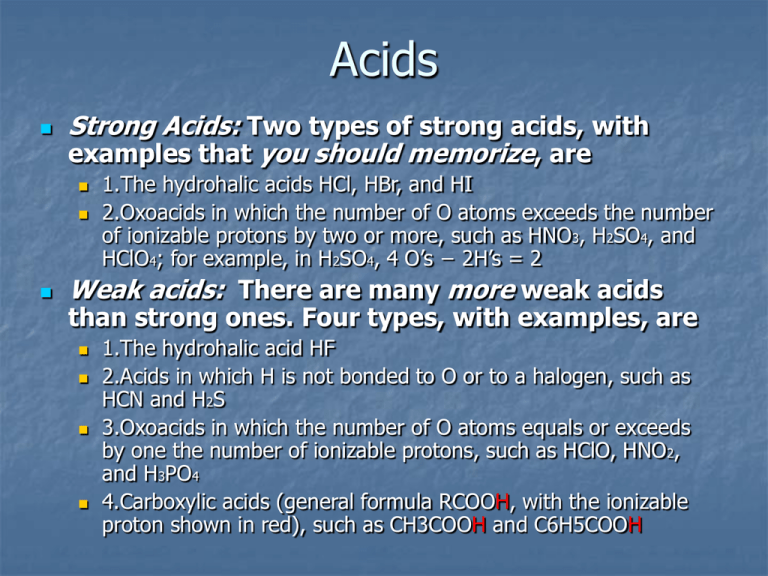
Acids Strong Acids: Two types of strong acids, with examples that you should memorize, are 1.The hydrohalic acids HCl, HBr, and HI 2.Oxoacids in which the number of O atoms exceeds the number of ionizable protons by two or more, such as HNO3, H2SO4, and HClO4; for example, in H2SO4, 4 O’s − 2H’s = 2 Weak acids: There are many more weak acids than strong ones. Four types, with examples, are 1.The hydrohalic acid HF 2.Acids in which H is not bonded to O or to a halogen, such as HCN and H2S 3.Oxoacids in which the number of O atoms equals or exceeds by one the number of ionizable protons, such as HClO, HNO2, and H3PO4 4.Carboxylic acids (general formula RCOOH, with the ionizable proton shown in red), such as CH3COOH and C6H5COOH Bases Strong bases: Water-soluble compounds containing O2− or OH− ions are strong bases. The cations are usually those of the most active metals: 1.M2O or MOH, where M = Group 1A(1) metal (Li, Na, K, Rb, Cs) 2.MO or M(OH)2, where M = Group 2A(2) metal (Ca, Sr, Ba) [MgO and Mg(OH)2 are only slightly soluble in water, but the soluble portion dissociates completely.] Weak bases: Many compounds with an electron- rich nitrogen atom are weak bases (none are Arrhenius bases). The common structural feature is an N atom with a lone electron pair: 1.Ammonia 2.Amines R-NH2 Bronsted-Lowry Acid-Base Model This model focuses on the nature of acids and bases and the reactions between them. Definitions: Acid – proton (H+ ion) donor Base – proton (H+ ion) acceptor In an acid-base reaction, a proton is transferred from an acid to a base: HB + A- ⇌ HA + BConjugate base: the species formed when a proton is removed from the acid. Conjugate acid: the species formed when a proton is added to a base. Conjugate Acids & Bases H2S + NH3 ⇌ HS− + NH4+ Example 1: For the equation above list the Bronsted-Lowry Acids and Bases Ans: Acids - H2S, NH4+ Bases - HS-, NH3 Example 2: For the substances below list the B-L Bases Conjugate Acid HF -- Ans: F- HSO4- -- NH4+ -- Ans: SO42Ans: NH3 Conjugate Base Amphiprotic A species that can either accept or donate a proton. For example: Water is amphiprotic: H2O + H2O ⇌ H3O+ + OHExample 3: What is the conjugate acid and base for The bicarbonate ion Ans: H2CO3, CO32- Hydrogen sulfate ion Ans: H2S, S2- The Ion Product of Water: The ionization of water can be simplified to the ionization of one water molecule: H2O ⇌ H+ (aq) + OH- (aq) The ion product constant of water @ 25⁰C: Kw = [H+] [OH-] = 1.0 x 10-14 Ion Product Concentration of Water The concentrations of H+ (H+ = H3O+) and OH- ions are can be calculated from the Kw in pure water @ 25⁰C When the H+ ions equal the OH- ions the solution is said to be a neutral solution: If [H+] is > 1.0 x 10-7, [OH-] < 1.0 x 10-7 solution is acidic If [OH-] is > 1.0 x 10-7, [H+] < 1.0 x 10-7 solution is basic These 2 quantities have an inversely proportional relationship pH This is an alternative method for specifying the acidity of a solution. pH stands for the power of the hydrogen ion and can be found using the following: pH = -log[H+] = -log[H3O+] or the same formula can be used to determine the [H+] concentration by: [H+] = 10-pH Determining acidic or basic: Acidic = pH < 7, the lower the # the more acidic the solution Basic = pH > 7, the higher the # the more basic the solution Neutral = pH = 7 pOH A similar approach is used to determine the hydroxide ion concentration: pOH = -log[OH-] Because [H+] [OH-] = 1.0 x 10-14 then the pH and pOH are connected by the following: pH + pOH = 14.00 Calculating pH and pOH Example 4: At 25 oC, calculate the hydrogen ion concentration and pH of a tap-water sample in which the hydroxide ion concentration is 2.0 x 10-7. The hydrogen and hydroxide ion concentrations of human blood at a pH of 7.40. Ans: 5.0 x 10-8M Ans: 4.0 x 10-8M, 2.5 x 10-7M The pOH of a solution in which the [H+] = 5.0[OH-]. Ans: 7.35 Strong Acids & Bases The pH of strong acids and bases ionize completely in water and because of this it is relatively easy to determine the pH and pOH. Example 5: What is the pH of a solution prepared by dissolving 1.00 g of barium hydroxide per liter? Ans: 12.07 Weak Acids & Their Equilibrium Constants Weak acids react reversibly with water to form H+ ions. Most weak acids fall into two categories: 1. Molecules containing an ionizable hydrogen atom: HNO2 (aq) (aq) + H2O ⇌ H3O+ (aq) + NO2- 2. Cations. The ammonium ion acts as a weak acid in water. NH4+ (aq) + H2O ⇌ H3O+ (aq) + NH3 Ka The equilibrium constant for a weak acid: HX ⇌ H+ + XKa = [H+] [X-] [HX] *the smaller the Ka value the weaker the acid. pKa We sometimes use a pKa value for weak acids: pKa = -logKa The larger the pKa the weaker the acid. Example 6: consider acetic acid (ka=1.8 x 10-5) and the tetraaquazinc(II) ion (ka=3.3 x 10-10) . Write the equations to show why these species are acidic. Which is the stronger acid? Ans: acetic acid What is the pKa of the tetraaquazinc ion? Ans: 9.48 Calculating Ka using an equilibrium table… Example 7: Aspirin is a weak organic acid whose molecular formula maybe written as HC9H7O4. A water solution of aspirin is prepared by dissolving 3.60 g per liter. The pH of the solution is found to be 2.60. Calculate the Ka for aspirin. Ans: 3.6 x 10-4 % Ionization Percent Ionization allows us to measure the percent of H+ ion that are ionized: % ionization = [H+] x 100 [HX] Example 8: What percent of H+ ions from the aspirin ionized in the previous example? Ans: 12% Example 9 Nicotinic acid, HC6H4O2N (Ka = 1.4 x 10-5), is another name for niacin, an important member of the vitamin B group. Determine the [H+] in a solution prepared by dissolving 0.10 mol of nicotinic acid, HNic, in water to form one liter of solution. [H+] = 1.2 x 10-3 M Polyprotic Weak Acids These are acids that have more than one ionizable hydrogen ion. These acids ionize in steps, with a separate equilibrium constant for each one: H2C2O4 (aq) ⇌ H+ (aq) + HC2O4- (aq) ⇌ H+ (aq) + HC2O4C2O4-2 Ka1 = 5.9 x 10-2 Ka2 = 5.2 x 10-5 The anion formed in step one produces another H+ ion in the next step. The Ka becomes smaller with each successive step: Ka1 > Ka2 > Ka3 Calculating pH of a polyprotic acid Example 10: The distilled water you use in the laboratory is slightly acidic because of dissolved carbon dioxide, which reacts to form carbonic acid. Calculate the pH of a 0.0010 M solution of carbonic acid (Ka1 = 4.4 x 10-7, Ka2 = 4.7 x 10-11). Ans: 4.68 Weak Bases & Their Equilibrium Constants Most weak bases, like acids, fall into two categories: 1. Molecules, including organic compounds known as amines: NH3 F- (aq) + H2O ⇌ NH4+ (aq) + OH- (aq) 2. Anion. An anion derived from a weak acid is itself a weak base: (aq) + H2O ⇌ HF (aq) + OH- (aq) Weak Bases Example 11: Write an equation to explain why each of the following produces a basic water solution. NO2Na2CO3 KHCO3 Calculation of [OH-] Example 12: Calculate the pH of a 0.10 M NaF (Kb = 1.4 x 10-11). Ans: 8.08 Ka and Kb The Ka of a weak acid and the Kb of a weak base will equal Kw: The stronger the acid the weaker its conjugate base and vice versa for bases. Acid-Base Properties of Solutions A salt is an ionic solid containing a cation other than H+ and an anion other than OH-. It is important to remember that anions of strong acids and cations of strong bases are neutral in solution. All other cations will be acidic in nature. All other anions will be basic in nature. To predict whether a given salt solution will be acidic, basic, or neutral, consider the three factors: 1. Decide what effect, if any, the cation has on the pH of water. 2. Decide what effect, if any, the anion will have on the pH of water. 3. Combine the 2 effects to decide the behavior of the salt. If both cation and anion have a K value, the one with the larger value decides acidic or basic. Salts: Acidic, Basic, Neutral? Example 13: Consider water solutions of the following six salts and identify if the solution are acidic, basic, or neutral: Ammonium iodide Zinc nitrate Ans: basic Ammonium fluoride Ans: neutral Sodium phosphate Ans: acidic Potassium perchlorate Ans: acidic Ans: acidic Ammonium hypochlorite Ans: basic MC #1 Which of the following ions is the strongest Lewis acid? (A) Na+ (B) Cl¯ (C) CH3COO¯ (D) Mg2+ (E) Al3+ MC #2 Each of the following can act as both a Brönsted acid and a Brönsted base EXCEPT (A) HCO3¯ (B) H2PO4¯ (C) NH4+ (D) H2O (E) HS¯ MC #3 Which, if any, of the following species is in the greatest concentration in a 0.100-molar solution of H2SO4 in water? (A) H2SO4 molecules (B) H3O+ ions (C) HSO4¯ ions (D) SO42¯ ions (E) All species are in equilibrium and therefore have the same concentrations. MC #4 Which of the following reactions does NOT proceed significantly to the right in aqueous solutions? (A) H3O+ + OH¯ ---> 2 H2O (B) HCN + OH¯ ---> H2O + CN¯ (C) Cu(H2O)42+ + 4 NH3 ---> Cu(NH3)42+ + 4H2O (D) H2SO4 + H2O ---> H3O+ + HSO4¯ (E) H2O + HSO4¯ ---> H2SO4 + OH¯ MC #5 If the acid dissociation constant, Ka, for an acid HA is 8 x 10¯4 at 25 °C, what percent of the acid is dissociated in a 0.50-molar solution of HA at 25 °C? (A) 0.08% (B) 0.2% (C) 1% (D) 2% (E) 4% MC #6 All of the following species can function as Brönsted-Lowry bases in solution EXCEPT (A) H2O (B) NH3 (C) S2¯ (D) NH4+ (E) HCO3¯ MC #7 As the number of oxygen atoms increases in any series of oxygen acids, such as HXO, HXO2, HXO3, ...., which of the following is generally true? (A) The acid strength varies unpredictably. (B) The acid strength decreases only if X is a nonmetal. (C) The acid strength decreases only if X is a metal. (D) The acid strength decreases whether X is a nonmetal or a metal. (E) The acid strength increases. MC #8 A 0.20-molar solution of a weak monoprotic acid, HA, has a pH of 3.00. The ionization constant of this acid is (A) 5.0 x 10¯7 (B) 2.0 x 10¯7 (C) 5.0 x 10¯6 (D) 5.0 x 10¯3 (E) 2.0 x 10¯3 MC #9 HSO4¯ + H2O <===> H3O+ + SO42– In the equilibrium represented above, the species that act as bases include which of the following? I. HSO4¯ II. H2O III. SO42– (A) II only (B) III only (C) I and II (D) I and III (E) II and III MC #10 H2C2O4 + 2H2O <===> 2H3O+ + C2O42¯ Oxalic acid, H2C2O4, is a diprotic acid with K1 = 5 x 10¯2 and K2 = 5 x 10¯5. Which of the following is equal to the equilibrium constant for the reaction represented above? (A) 5 x 10¯2 (B) 5 x 10¯5 (C) 2.5 x 10¯6 (D) 5 x 10¯7 (E) 2.5 x 10¯8 MC #11 A 1-molar solution of which of the following salts has the highest pH ? (A) NaNO3 (B) Na2CO3 (C) NH4Cl (D) NaHSO4 (E) Na2SO4 MC #12 What is the pH of a 1.0 x 10¯2 M solution of HCN? (Ka = 4.0 x 10¯10.) (A) 10 (B) Between 7 and 10 (C) 7 (D) Between 4 and 7 (E) 4 MC #13 The net ionic equation for the reaction that occurs during the titration of nitrous aicd with sodium hydroxide is (A) HNO2 + Na+ + OH¯ ---> NaNO2 + H2O (B) HNO2 + NaOH ---> Na+ + NO2¯ + H2O (C) H+ + OH¯ --->H2O (D) HNO2 + H2O ---> NO2¯ + H3O+ (E) HNO2 + OH¯ ---> NO2¯ + H2O MC #14 What is the H+ (aq) concentration in 0.05 M HCN (aq)? (The Ka for HCN is 5.0 x 10¯10) (A) 2.5 x 10¯11 (B) 2.5 x 10¯10 (C) 5.0 x 10¯10 (D) 5.0 x 10¯6 (E) 5.0 x 10¯4 MC #15 A molecule or an ion is classified as a Lewis acid if it (A) accepts a proton from water (B) accepts a pair of electrons to form a bond (C) donates a pair of electrons to form a bond (D) donates a proton to water (E) has resonance Lewis electron-dot structures FRQ #1 A pure 14.85 g sample of the weak base ethylamine, C2H5NH2 , is dissolved in enough distilled water to make 500. mL of solution. (a) Calculate the molar concentration of the C2H5NH2 in the solution. The aqueous ethylamine reacts with water according to the equation below. C2H5NH2(aq) + H2O(l) C2H5NH3+(aq) + OH-(aq) (b) Write the equilibrium-constant expression for the reaction between C2H5NH2(aq) and water. (c) Of C2H5NH2(aq) and C2H5NH3+(aq), which is present in the solution at the higher concentration at equilibrium? Justify your answer. *(d) A different solution is made by mixing 500. mL of 0.500 M C2H5NH2 with 500. mL of 0.200 M HCl. Assume that volumes are additive. The pH of the resulting solution is found to be 10.93. (i) Calculate the concentration of OH-(aq) in the solution. (ii) Write the net-ionic equation that represents the reaction that occurs when the C2H5NH2 solution is mixed with the HCl solution. (iii) Calculate the molar concentration of the C2H5NH3+(aq) that is formed in the reaction. (iv) Calculate the value of Kb for C2H5NH2. FRQ #2 HF(aq) + H2O(l) H3O+(aq) + F–(aq) Ka = 7.2×10–4 Hydrofluoric acid, HF, dissociates in water as represented by the equation above. (a) Write the equilibrium-constant expression for the dissociation of HF in water. (b) Calculate the molar concentration of H3O+ in a 0.40 M HF solution. HF(aq) reacts with NaOH(aq) according to the reaction represented below. HF(aq) + OH–(aq) H2O(l) + F–(aq) A volume of 15 mL of 0.40 M NaOH(aq) is added to 25 mL of 0.40 M HF(aq) solution. Assume that volumes are additive. *(c) Calculate the number of moles of HF(aq) remaining in the solution. (d) Calculate the molar concentration of F–(aq) in the solution. (e) Calculate the pH of the solution. FRQ #3 HC3H5O2(aq) ↔ C3H5O2– (aq) + H+(aq) Ka = 1.34 x 10–5 Propanoic acid, HC3H5O2, ionizes in water according to the equation above. (a) Write the equilibrium constant expression for the reaction. (b) Calculate the pH of a 0.265 M solution of propanoic acid. (c) A 0.496 g sample of sodium propanoate, NaC3H5O2, is added to a 50.0 mL sample of a 0.265 M solution of propanoic acid. Assuming that no change in the volume of the solution occurs, calculate each of the following. (i) The concentration of the propanoate ion, C3H5O2–(aq) in the solution (ii) The concentration of the H+(aq) ion in the solution. The methanoate ion, HCO2–(aq) reacts with water to form methanoic acid and hydroxide ion, as shown in the following equation. HCO2–(aq) + H2O (l) ↔ H2CO2(aq) + OH–(aq) *(d) Given that [OH–] is 4.18 x 10–6 M in a 0.309 M solution of sodium methanoate, calculate each of the following. (i) The value of Kb for the methanoate ion, HCO2–(aq) (ii) The value of Ka for methanoic acid, HCO2H *(e) Which acid is stronger, propanoic acid or methanoic acid? Justify your answer. FRQ #4 Hypochlorous acid, HOCl, is a weak acid commonly used as a bleaching agent. The acid–dissociation constant, Ka, for the reaction represented above is 3.2×10–8. (a) Calculate the [H+] of a 0.14–molar solution of HOCl. (b) Write the correctly balanced net ionic equation for the reaction that occurs when NaOCl is dissolved in water and calculate the numerical value of the equilibrium constant for the reaction. *(c) Calculate the pH of a solution made by combining 40.0 milliliters of 0.14–molar HOCl and 10.0 milliliters of 0.56–molar NaOH. FRQ #5 Give a brief explanation for each of the following. (a) For the diprotic acid H2S, the first dissociation constant is larger than the second dissociation constant by about 105 (K1 ~ 105 K2). (b) In water, NaOH is a base but HOCl is an acid. (c) HCl and HI are equally strong acids in water but, in pure acetic acid, HI is a stronger acid than HCl. (d) When each is dissolved in water, HCl is a much stronger acid than HF.
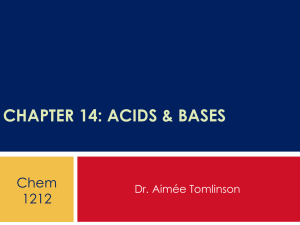

![pH = - log [H + ]](http://s2.studylib.net/store/data/005622524_1-002df1ea50d2a849b15deb604928664e-300x300.png)
